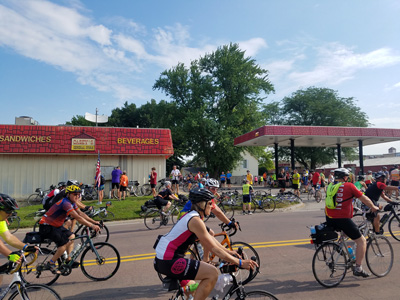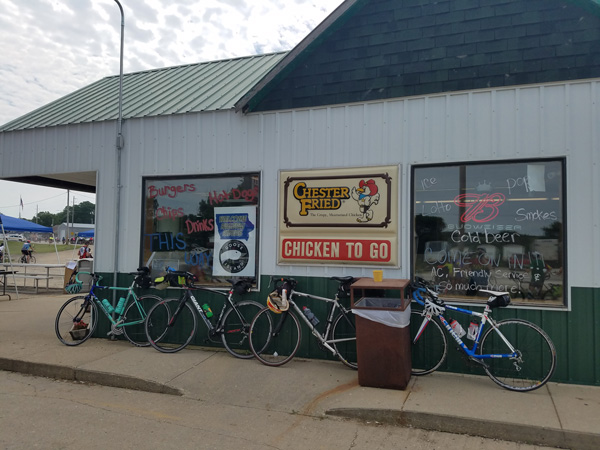By Frank Beard
If you’re an active cyclist, then you might be familiar with the Register’s Annual Great Bicycle Ride Across Iowa (RAGBRAI). Held annually since 1973, this is the oldest, largest and longest bicycle touring event in the world. As many as 15,000 or more riders may participate on any given day.
I rode this year with a team and logged more than 460 miles in seven days. We passed through rural communities, small towns and a few of Iowa’s larger cities. I also visited many convenience retailers since this environment provided a unique perspective—both as a consumer and observer. Here are four lessons worth unpacking.
 1. Leverage special events to boost sales
1. Leverage special events to boost sales
Some retailers were prepared for RAGBRAI. The Casey’s General Store in New Sharon, Iowa—the single town on an optional loop that added an extra 36.7 miles—placed a large variety of sunscreens near every register. They nearly sold out. An independent retailer in another town welcomed riders inside with messaging on the windows about “cold beer, AC, friendly service and so much more.” Yesway even set up a canopy in one overnight town and promoted their brand with handouts and prizes.

But other retailers did nothing unique. This was surprising because thousands of hungry and thirsty cyclists are a great opportunity to boost sales. And with riders coming from as far away as Dubai and Australia, many were willing to stop in each town and explore the stores. The right message could have drawn them inside.
RAGBRAI is unique, but brands also stand to benefit when they engage holidays, sporting events and other special moments. The potential upside is great enough that some retailers have created their own holidays—as 7-Eleven did in 2002, using 7-Eleven Day to celebrate the Slurpee’s birthday. According to GasBuddy data, this year’s promotion resulted in a 51% increase in foot traffic on July 11.
2. Eliminate the pain points in your checkout process
Even the checkout line is under the microscope in today's evolving retail landscape. Amazon Go showed us that it’s possible to “just walk out,” and cashierless technology soon may be available in other stores, even at Walmart.
This comes at a time when customers already are intolerant of long lines. A 2015 Harris Poll and Digimarc Corp. survey found that 88% of U.S. adults want their store checkout experience to be quicker. A 2016 survey from Chick-Fil-A revealed that 82% of diners would do “almost anything” to avoid long lines at fast-food restaurants when they’re with their children, and 48% of millennial parents would rather not eat at all than stand in a line. And when Capgemini surveyed consumers worldwide, 66% said long lines at checkout counters was one of the things that frustrates them most about physical retail.
I experienced this frustration myself during RAGBRAI. I walked in one store to purchase a snack bar, and left after discovering at least 40 people standing in a line that wrapped around the perimeter and began near the door. The two cashiers seemed to be in no apparent hurry. At another retailer, the cashier wasted time asking about loyalty cards despite the fact that many customers were from other states.
Whether it’s RAGBRAI cyclists or a rush during the morning commute, convenience stores are the last place consumers should encounter long lines. Lines are contrary to the industry’s time-saving value proposition. In the near future, I suspect many customers will “just walk away” from the brands that fail to eliminate long lines.
3. Differentiate your brand
Some of the small-town retailers I visited were basic and unremarkable in both experience and product selection. Beyond necessity and impulse, there was no apparent reason for customers to come inside the store.
I suspect that these retailers felt comfortable from the lack of competition, but that’s not necessarily a safe bet in today’s retail environment. Case in point: I also encountered many newly constructed Dollar General locations—rural America’s store of choice, according to the Wall Street Journal.
This is concerning, because Dollar General poses a competitive threat to undifferentiated rural retailers. As retail analyst Nick Egelanian told Retail Dive, the dollar store industry has become the “mini-grocery store,” and the stores are geared toward “working class, budget-minded consumers." Dollar General also is expanding rapidly. The chain opened 1,315 locations in 2017 and plans to open 900 more for 2018 and to remodel another 1,000.
4. Aim for authentic customer service
Events such as RAGBRAI shine a light on inauthentic, robotic customer service. Cyclists want to chat with employees as they visit stores, and it’s difficult to do that if you’re talking to a script.
Fortunately, most of the customer service I encountered was fantastic. I visited a Casey’s General Store, where the cashier collected loose change that cash-only cyclists didn’t want. When my total for a snack bar came to just over $2, she covered the remainder. “I got this,” she said, smiling and pointing to the small pile of change.
At an independent retailer, I made pleasant small talk with the lady behind the counter, who I assume was the owner. She was ecstatic at the momentary bump in business, taking joy in the challenge of keeping the line as short as possible. Standing next to her were two young girls hoping to make extra money for the store by selling Smarties Double Lollies to cyclists. It was the kind of warm, welcoming environment typical of many rural Iowa convenience stores. RAGBRAI or not, a bit of authentic customer service goes a long way.
Frank Beard is a regular NACS Daily contributor who has traveled to more than 1,000 convenience stores in 24 states. He raised awareness of the industry's healthful food options with his “30 Days of Gas Station Food” experiment, and he's an analyst/evangelist for convenience store and retail trends at GasBuddy. Follow Frank on Twitter here.